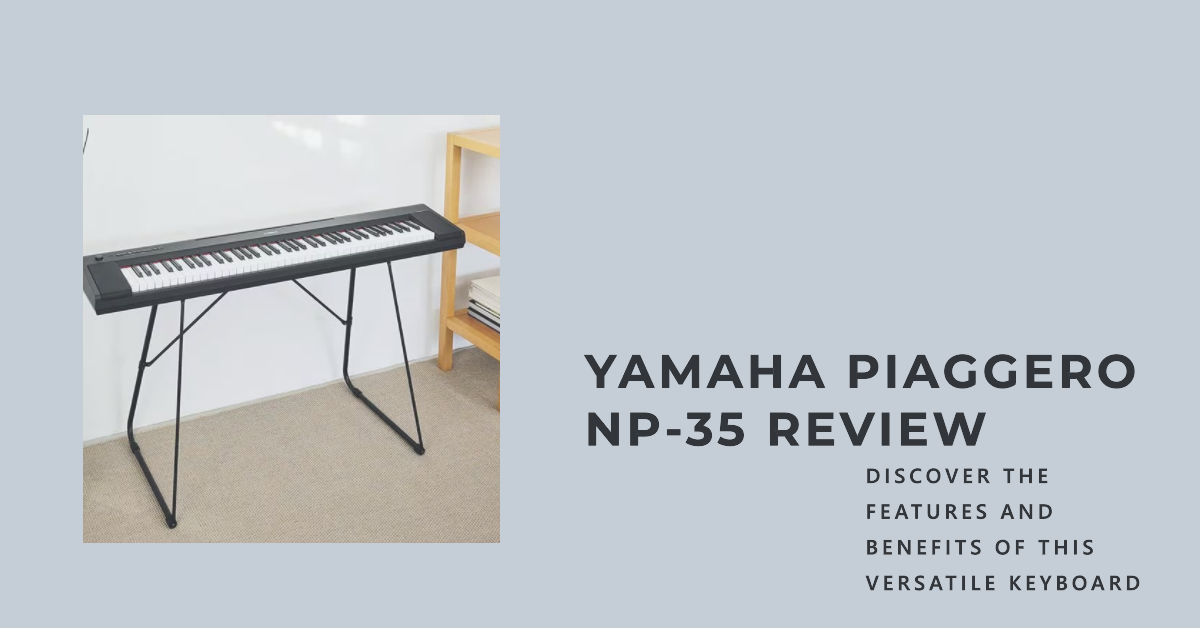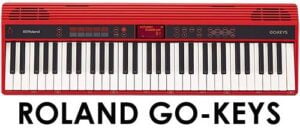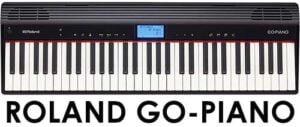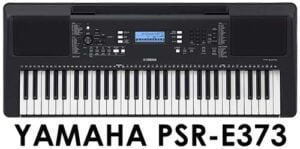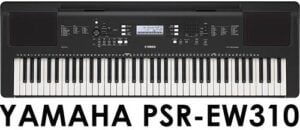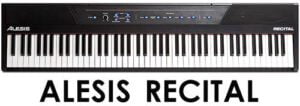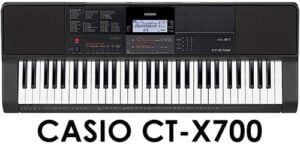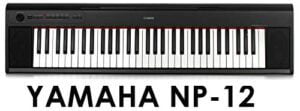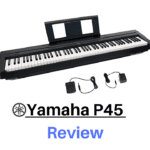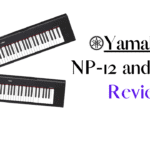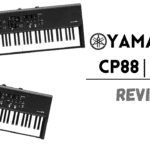As an experienced piano teacher and professional musician, I get asked all the time – “What’s the best beginner keyboard piano for learning and practicing?”
My answer? The Yamaha Piaggero NP-35.
In this in-depth review, I’ll cover everything you need to know about the NP-35 – its sounds, key action, features, build quality and more. I’ll also compare it to other beginner keyboards in its price range.
If you’re looking to buy your first piano keyboard, you’ll find this review super helpful. I’ve played and tested just about every beginner digital piano out there. So trust me when I say the NP-35 hits the sweet spot between price, portability and quality.
Let’s dive in!
Overview of the Yamaha NP-35
Main Features:
- 76 Graded Soft Touch Keys
- 15 High-Quality Instrument Sounds
- 64 Note Polyphony
- Reverb, Octave Shift, Sound Boost
- Weighs Only 13.25 lbs
- Optional Battery Power
- USB and MIDI Connectivity
- Yamaha Smart Pianist App Compatible
The Piaggero NP-35 replaces Yamaha’s older NP-32 model. It’s an ultra-portable digital piano ideal for beginners, students and hobbyists.
Despite its low price tag (under $400), the NP-35 packs a surprising amount of features and sound quality. As I’ll explain below, it uses many of the same technologies found in Yamaha’s high-end Arius digital pianos.
Let’s look at the NP-35’s main features in detail:
Sounds and Tones
The NP-35 comes with 15 instrument sounds built-in:
- 3 Acoustic Pianos
- 3 Electric Pianos
- 2 Pipe Organs
- 1 Jazz Organ
- 2 Harpsichords
- 1 Vibraphone
- 3 Strings/Pads
The main Default piano sound is sampled from Yamaha’s renowned CFIIIS 9-foot concert grand piano. It sounds full, natural and expressive across the entire dynamic range.
Many cheap keyboards only sample the midrange notes. But the NP-35 faithfully reproduces the resonance and tone of the low bass notes and the sparkling clear treble notes. Half-pedaling and damper resonance further enhance the realism.
The electric pianos, organs and strings provide a nice variety of different musical styles. And you can layer two sounds together – for example Piano and Strings – and adjust their volume balance.
Overall, the NP-35’s 15 instrument sounds are far better than anything else you’ll find in this price range. They’re good enough for performing live, not just practicing at home.
Polyphony
Polyphony refers to how many notes the keyboard can play or sound at once. More is always better, especially for advanced piano pieces with lots of sustain pedals.
With 64-note polyphony, the NP-35 provides enough power for any beginner. Experienced players may run into dropped notes when playing dense classical compositions. But 64 is typical for portable keyboards in this price range.
Key Action
The NP-35 has 76 touch-sensitive keys with a graded soft-touch action. The keys feel lighter in the high end and heavier in the low end, just like an acoustic piano.
Four velocity sensitivity settings allow you to customize the key feel – from very light to moderately heavy. This is great for tailoring the keyboard to younger students or older beginners.
The keys are plastic with a matte finish to absorb sweat and moisture. I really like the simulated ivory keytops – they feel smooth without being slippery.
The black keys have a textured surface which makes it easy to orient your fingers without looking down. Red felt underneath each key keeps the action quiet and dust-free.
While not fully weighted, the NP-35’s soft touch action is very playable for beginners. Don’t underestimate the benefit of lightweight keys when you’re just starting out. My students find 76-keys less fatiguing than heavy 88-key digital pianos.
Sound System
The NP-35 features upgraded 12W speakers and amplifiers. It has a nice full sound that won’t distort, even at maximum volume.
Yamaha also added a special Sound Boost button. This really pumps up the volume and bass response – perfect for jamming with drums and guitars.
Headphones plug into a 1/4″ stereo jack, allowing an immersive, private practice experience.
Effects
Six different reverb types (Room, Hall, Stage etc) let you change the “space” your piano is playing in. Reverb adds richness and ambience to the sound.
The NP-35 also has an intelligent Acoustic Resonance effect exclusive to Yamaha digital pianos. It recreates the deep resonance of the piano soundboard you feel when playing softly.
Connectivity
- USB to Host – For connecting to computers and mobile devices
- Headphone Jacks – 1/4″ stereo headphone jack
- Pedal Jack – For connecting a sustain pedal
- Power Supply- 6 x AA, 12V DC (1.5A) power supply (included)
The USB port allows MIDI and audio data transfer. You can record performances as audio files on a computer DAW. Or use MIDI to control VST plugins from the NP-35 keyboard.
Unfortunately, there’s no dedicated Line Out jacks like on higher-priced digital pianos. You’ll need a 1/4″ to RCA cable to connect to an amp, PA system or audio interface.
Portability
Weighing in at only 13 lbs, the NP-35 is one of the most portable 76-key digital pianos available. The lightweight keys and plastic chassis keep the weight down.
It runs on 6x AA batteries, allowing up to 4 hours of cordless use. Battery power gives you true portability for playing anywhere.
While not marketed as a stage piano, the NP-35 is certainly portable enough for gigging. Just add an X-style keyboard stand and you’ve got a pro-quality live performance rig.
Smart Pianist App
The NP-35 works seamlessly with Yamaha’s Smart Pianist app for iOS and Android devices. Smart Pianist opens up extra features like:
- Hundreds of Additional Instrument Voices
- Multi-track Recorder
- Visual EQ and Reverb Controls
- Score Display
- Chord Chart Display
- Performance Analytics
It’s an easy way to expand the NP-35’s functionality without having to learn advanced MIDI concepts. Just connect your phone or tablet to the USB port and Smart Pianist automatically syncs with the keyboard.
Optional Accessories
Yamaha offers a few optional accessories that enhance the NP-35:
- LP5A Pedal Unit – Fully supports half-pedaling and recreates the feeling of an acoustic piano’s damper pedal.
- Keyboard Stand – Sturdy X-style stand that raises the NP-35 to a better playing height.
- Headphones – Quality over-ear headphones provide immersive piano sound for private practice.
- Aux Cables – For connecting to phones, computers, mixers etc.
- Gig Bag/Case – Padded case protects the NP-35 during transport. Has handles and a shoulder strap.
- Bench Padded Keyboard Bench – Gives proper piano posture during practice.
Yamaha NP-35 vs Competition
Yamaha NP-35 vs Casio CT-S200
The Casio CT-S200 is another great beginner’s keyboard available for under $400.
The NP-35 sounds noticeably better to my ear. The Casio has mini keys which some students may find too small.
But the Casio provides bluetooth connectivity for wireless MIDI and audio. So if that’s important to you, the Casio may be a better choice.
I give Yamaha a slight edge overall, but it’s close. Both are great starter keyboards.
Yamaha NP-35 vs Yamaha PSR-E373
The PSR-E373 is Yamaha’s competitor model with 61 full-size keys. It has double the polyphony (128 notes vs 64) and over 500 instrument sounds.
However, the NP-35 has a nicer key action optimized for piano playing. The weighted action on the PSR-E373 feels stiff and synth-like in comparison.
So unless you need lots of sounds and polyphony, I recommend the NP-35 for students focused just on piano performance.
Yamaha NP-35 vs Roland Go:Keys
Roland’s GO: Keys line provides an ultra-portable alternative to the NP-35. The 61-key GO:61P has an even lower weight of 9 lbs.
The Roland sounds quite toy-like to me though. It’s more of a fun practice tool than a piano replacement.
The NP-35 simply provides a more realistic and enjoyable playing experience for pianists.
Yamaha NP-35 vs Alesis Recital Pro
The Alesis Recital Pro gives you 88 hammer-action keys at a similar price point as the NP-35. So if piano-style weighted keys are important, it may be the better choice.
However, Alesis is not on the same level as Yamaha for authentic piano sound. The NP-35 uses much higher quality samples and effects.
So you’re trading sound quality and portability for a full-weighted keyboard. Depends on your priorities as a beginner player.
Yamaha NP-35 Review – Summary
Let’s recap the main Pros and Cons of the Yamaha Piaggero NP-35:
Pros
- Great piano sound throughout entire dynamic range
- Nice key action with simulated ivory feel
- 6 Reverb types and Resonance effect
- Ultra-light and portable
- iOS/Android app adds extra features
- Good value under $400
Cons
- Only 15 instrument sounds
- No display screen
- No line-out jacks
- Keys are plastic not wood
- Optional accessories add to cost
As you can see, the NP-35 isn’t perfect. But at this low price point, nothing else comes close in terms of authentic piano touch and sound.
The lightweight design does require some plastic parts to keep costs down. But the overall build quality exceeds my expectations for an under $400 keyboard.
If you’re on a tight budget, or just starting out, I don’t think you can find a better value digital piano than the Yamaha NP-35. It provides a great foundation for learning proper piano technique.
Down the road, you can always upgrade to a fancier keyboard with more features. The piano skills you develop on the NP-35 will transfer seamlessly to any other model.
So in summary, I highly recommend the Yamaha Piaggero NP-35 as an affordable, yet quality digital piano for beginners of all ages. It hits a sweet spot that’s hard to beat in the sub-$400 price range.
To purchase the Yamaha NP-35, click the link below:
Get the Yamaha NP-35 Keyboard on Sweetwater
Now over to you – do you have any experience with the NP-35 or own one yourself? Let me know in the comments below!

